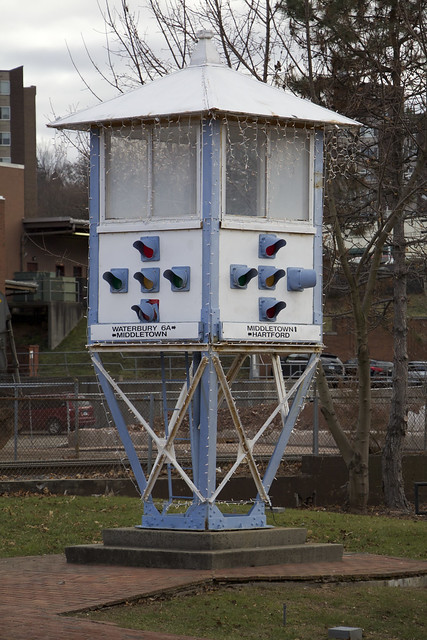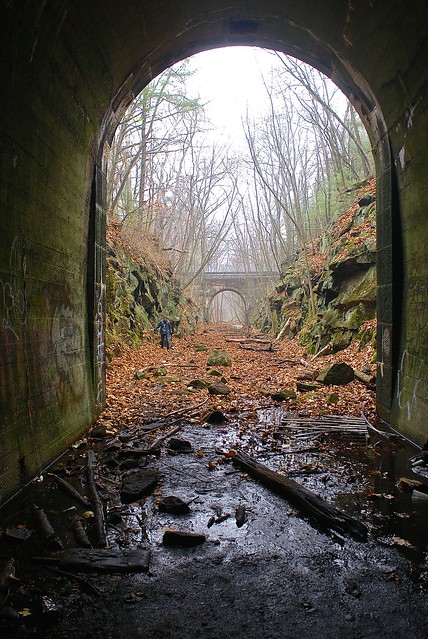From Dave Brigham:

This historic home is the gateway to the Kendal Green Historic District in Weston, Massachusetts. Known as the Hobbs-Hagar House, it was built in 1786 by Isaac Hobbs Jr., one in a long line from that family to live, work and employ folks in the old farming town that more recently has become a swanky Boston suburb.
"In 1729, Josiah Hobbs purchased 122 acres along North Avenue at the heart of the Kendal Green Historic District, including water rights to what is now known as 'Hobbs Brook,'" according to the Weston Historical Commission. "The Hobbs Tannery, which may have been established as early as 1730, was among the first tanneries in the Massachusetts colony and was so well-known that it was a custom in early days to locate houses and people in Weston by their distance from the tannery."
Across North Avenue (aka Route 117) from the Hobbs-Hagar House sits the Isaac Hobbs House, built in 1758 by Isaac Hobbs Sr.

(Isaac Hobbs House.)
Down the backyard slope is Hobbs Brook, where the Hobbs family operated its tannery for more than 100 years. Members of the Hobbs clan also operated a slaughterhouse and a factory making shoes, belts, boots and other leather products, according to the Weston Historical Commission.
"Probably because of the presence of the tannery, boots and shoes were the principal articles manufactured in Weston by the late 1830s, according to John Warner Barber’s Historical Collections. Barber reported that in 1837, 5,606 pairs of boots and 17,182 pairs of shoes were manufactured in the town, a figure thought to represent about the peak of the leather industry here. The firm of Hobbs and Hagar continued the shoe factory until about 1850 and the tannery closed shortly before the death of Nathan Hagar in 1860." -- Weston Historical Commission

(Approximate location of old Hobbs tannery.)
Over the past two years, I've driven through the Kendal Green Historic District hundreds of times, on my way to and from my son's school. The area was named in 1885 by a Hobbs relative, Gen. James F.B. Marshall, commemorating his grandfather, Rev. Samuel Kendal, according to the Town of Weston web site. Driving by is all well and good, but you know my mantra: get out and walk! So I recently did just that and found more than I'd expected.
A few doors down from the Isaac Hobbs House is a house that served as the area's general store and post office for decades.

(Former general store/post office -- the sign by the door on the right indicates as such.)
A quick jog past the general store once sat the Drabbington Lodge (later known as the Westonian Inn).

(Former circa-1899 inn, now an assisted living facility.)
Across Route 117 (most of the district sits along this road) from the old inn sits a building that confounded me for years.

All concrete, with wooden doors and locked up tight, this building sits more or less in the front yard of a really nice home with an in-ground pool (thanks, Google Maps!), separated by a small grove of trees. Initially I figured it was an old garage for a house that had been torn down, or was perhaps hidden behind trees across the street. But after a Google search I learned that this is a fire station erected in 1908. I can't find anything online about what's inside, or why this building was saved. Since it's concrete, I imagine it would be extremely difficult, if not impossible, to move it somewhere else.
Back across North Avenue is the beautiful Whitney Tavern house.

(Whitney Tavern house.)
Even the Weston Historical Commission doesn't know much about the tavern, stating on its web site, "18th and early 19th century travelers may have stopped for refreshment at the Whitney Tavern at 171 North Avenue, reputed to have been built for William Whitney, who married Martha Pierce of Weston in 1706. Little is known of the early history of the tavern except for a brief caption in Lamson’s History of the Town of Weston, which says that Mr. Whitney, who owned and occupied it as a tavern, once kept the famous 'Punch Bowl' tavern in Brookline."

(The lot next to the Whitney Tavern house is empty, but judging from this wall, I'm sure there was a nice house here at some point.)
Hopscotching to the other side of Route 117, we see this wonderful Shingle-style home. It was built in 1890 by Francis Henry Hastings, who had recently overseen the construction of the Hook & Hastings organ factory just up the road.

When I learned there had once been an organ factory -- three stories high, with an 80-foot-long center section and two 100-foot wings -- amid the farm houses and regal Colonials on Route 117, I knew I had to walk this district, take photos and do a lot of research. I relished the opportunity.
Unfortunately, there is nothing left of the old factory, which was demolished in 1936 after Hook & Hastings went out of business. Homes have been built on the former site, so suburbex enthusiasts can't even walk the grounds looking for clues of any sort. Hastings Hall, a building near the factory used by employees and the public, is long gone, as is a one-room schoolhouse that Francis Hastings attended. For a great history of the factory, read this article by the Weston Historical Commission. To see a photo of the factory, along with other pictures of the Kendal Green Historic District, and to read more about the area, check this link.
Nevertheless, I found plenty of remnants of the organ factory days, and other leftovers from days gone by.

(126 Viles Street, a duplex, and one of two houses built in 1897 for workers of the organ factory that still stand in this location. The entrance to the factory was close to this spot, I believe, which is why my focus was on the driveway rather than the house.)

(The former Hook & Hastings factory playing field, near where Hastings Hall stood. The hall was demolished in 1944; the field now belongs to town of Weston. I walked around in the woods behind the field, to see if I could cross Stony Brook and poke around the edges of the neighborhood of expensive houses that replaced the factory. No dice.)
Across from the field sit six houses that were built in 1895 for factory workers, and a seventh that Hastings purchased for same. I was impressed by how well maintained these cottage-style houses are. While these homes are much smaller than the typical Weston house (median home value in this tony town: $1.465 million), the residents obviously have pride of ownership in these historic and somewhat unusual homes.

(Houses on Brook Road that were once factory worker homes.)
While many of the houses in the historic district are beautiful and maintain a sense of history about them, there are some that are simply average, and one that is quite rundown.

(Large shed/small house on property with a circa-1880 main house that is also in poor condition. I went to a yard sale here some time ago. The people were quite nice, but it seems they have a bit of a hoarding problem.)
Not only did Weston have an organ factory a long time ago, but the town also was home to the Weston Dog Ranch. This is the kind of fact I love digging up, er, well, finding online thanks to the Weston Historical Commission. A German immigrant named A.A. Lederhos, an ornamental iron worker by trade, began boarding dogs during the Depression to earn more money, according to this fantastic article, which I highly recommend you read (there are great photos, too). Lederhos designed an iron archway with the words "Weston Dog Ranch" and workers at his company, E.T. Ryan, built and installed it on the property, at 248 North Avenue.
Well, you know how the story goes, don't you? The house, garage and dog runs stayed intact and in business in one form or another, through a few owners, for many decades. In 1994, however, a developer bought the property, bulldozed everything, subdivided it and built 10 homes that back up to the railroad tracks.

(The approximate location of the former Weston Dog Ranch.)
Once I'd hit the northern end of the Kendal Green Historic District, I doubled back to the corner of North Avenue and Church Street, where the Hobbs-Hagar House is located, and took a short walk to the west to find this quaint old train station.

I've been unable to find much information about this place, which appears to be a private residence, despite sitting adjacent to an active commuter rail platform. The Weston Historical Commission indicates the station, now known as Kendal Green but formerly called Weston Station, was built in 1901.
The outer reaches of the historic district feature another old train station.

This station was also once known as Weston, but was located on a spur that split in nearby Waltham. Built in 1881 and closed in 1971, the station was once part of the Massachusetts Central Railroad. I believe this building is also privately owned, and may have been a home at one point. For more on this part of the Mass. Central Railroad, specifically the tracks going through Wayland, Mass., see August 1, 2016, "I Rail Against Trails (Not Really, But I Don't Want Every Set of Abandoned Train Tracks Converted for Cyclists and Roller Blades)."
Finally, there is the Church Street bridge going over the long-abandoned tracks next to this station.

At some point I hope to walk along this railroad right-of-way, as I know there is an old trestle heading toward Waltham, and who knows what else going westward. Stay tuned....





















